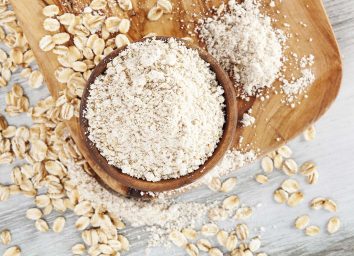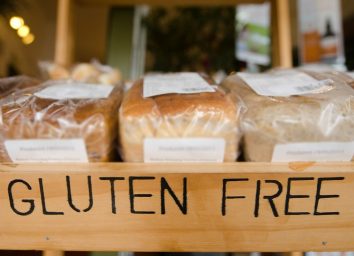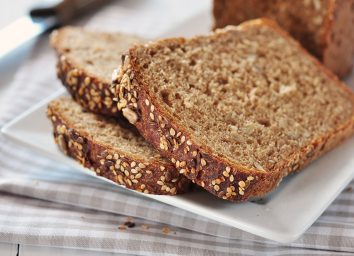What's the Difference Between Gluten Intolerance and Celiac Disease?

About 3 million people, or one percent of the U.S. population, have celiac disease. While an exact number doesn't exist on how many people have other gluten-related disorders, it's estimated to be much higher than those who have celiac, simply because many remain undiagnosed. Still, there is a lot of confusion between the two conditions, which is why we consulted Gabrielle Mancella, a registered dietitian at Orlando Health, to help us better understand the complexities of each.
What is celiac disease?
Celiac disease is an autoimmune disease that causes the body to have adverse reactions to gluten, which is a protein found in wheat, barley, and rye. If someone with celiac disease eats gluten, they risk damaging their small intestine.
"When people who have celiac disease eat gluten, the result is a reaction in their small intestine that can lead to symptoms such as diarrhea, abdominal pain, bloating, and weight loss," says Mancella.
Celiac disease is diagnosed through a simple blood test. Mancella says that people who have the autoimmune disease will have higher levels of certain antibodies in their blood after eating gluten.
"These antibodies are produced by the immune system because it views gluten as a threat," she explains.
In order for this blood test to be accurate, though, an individual must be eating gluten regularly. Otherwise, the antibodies will not show up.
Can you develop celiac disease later in life, or are you born with it?
Contrary to what some may believe, Mancella says that celiac disease can develop at any age. Celiac disease is hereditary, so those with a close relative that has it have a 1-in-10 risk of developing it, too.
"It is crucial that adults take initiative in their health and begin to pay attention to signs and symptoms of discomfort, as oftentimes, gluten intolerance, celiac, and even dairy intolerance have similar symptoms and it is difficult to discern amongst them," she adds.
What kinds of foods must someone avoid if they have celiac disease?
"The most cost-effective and healthy way to follow the gluten-free diet is to seek out these naturally gluten-free food groups, which include fruits, vegetables, poultry, seafood, dairy, beans, legumes, and nuts," says Mancella. "Pure wheatgrass and barley grass are gluten-free, but there is gluten in the seeds. If they are not harvested or processed correctly, there is a risk of gluten contamination."
Supermarkets are not short of gluten-free products, either. However, not all gluten-free alternatives are healthy substitutions. Oftentimes gluten-free bread, for example, can be packed with several additives to mimic the protein, some of which could affect the body over time. Mancella suggests placing more emphasis on incorporating foods that are minimally processed and are naturally void of gluten, such as the foods listed above. Other foods that are free of gluten include rice, quinoa, most oats, and even soy.
"It is also important to remember that 'wheat-free' does not necessarily mean gluten-free," Mancella clarifies. "As a rule, traditional wheat products such as pasta, bread, crackers, and other baked goods are not gluten-free."
Not all products that are naturally gluten-free will clearly advertise that they're gluten-free, which makes it all the more important to be independently well-versed in which ingredients contain gluten, and which don't.
Even then there remains a gray area of which ingredients may contain traces of gluten. Mancella says to be mindful of ingredients such as cornflakes and puffed rice, which could contain malt flavoring or extract and as a result, contaminate the otherwise gluten-free ingredient.
"Oats are often harvested and processed with the same equipment that is used for wheat and are therefore easily contaminated," she says. "Research indicates that pure, uncontaminated oats consumed in moderation—up to ½ cup dry rolled oats daily—are tolerated by most people with celiac disease."
When in doubt, purchase oats and oat-containing products (such as granola) specifically labeled gluten-free.
"Soups and sauces are one of the biggest sources of hidden gluten, as many companies use wheat as a thickener. It is always a good idea to read the label of any pre-prepared or canned soups and sauces, paying special attention to those that are cream-based," says Mancella.
Certain types of alcohol also contain gluten. Generally, distilled, hard liquors and ciders are free of gluten. Beer and malt-containing alcoholic beverages such as Smirnoff Ice do contain gluten.
What is gluten intolerance? Is this the same thing as gluten sensitivity?
"People with non-celiac wheat sensitivity experience symptoms similar to those of celiac disease, which resolve when gluten is removed from the diet. However, they do not test positive for celiac disease," says Mancella.
She adds that current research has unveiled what's called non-celiac gluten intolerance, which can cause digestive and gastrointestinal distress without triggering the destructive immune response that someone with celiac disease would experience.
"Some people [with the intolerance] experience symptoms found in celiac disease, such as foggy mind, depression, ADHD-like behavior, abdominal pain, bloating, diarrhea, constipation, headaches, bone or joint pain, and chronic fatigue when they have gluten in their diet, yet do not test positive for celiac disease," she says.
In general, non-celiac gluten sensitivity, non-celiac wheat sensitivity, and non-celiac gluten intolerance all refer to the same condition. However, a team of researchers at Columbia University Medical Center discovered something in a group of people with sensitivities to gluten and wheat that could distinguish the two terms.
Formerly, it was believed that people with wheat sensitivity did not experience intestinal damage upon ingestion of gluten, but results from a study published in 2016 may suggest otherwise. Researchers at Columbia discovered that those in the group who were exposed to wheat experienced some intestinal cell damage.
"It is estimated that the impacted population is equal to or even exceeds the number of individuals with celiac disease—the vast majority of whom remain undiagnosed," says Mancella.
What happens when someone with gluten intolerance or sensitivity eats gluten?
While someone with either an intolerance or a sensitivity to gluten will not experience an immune response to the same degree someone with celiac disease would, they will experience some GI issues due to the mal-absorption of the protein.
"We think of gluten intolerance as a fairly tolerable illness, though, if we are unable to fully metabolize and digest the micronutrients, this becomes an issue of vitamin and mineral deficiencies as well as fat-soluble vitamin deficiencies as a consequence of a diuretic effect on the digestive system," says Mancella.
In other words, gluten may inhibit the absorption of other vitamins and minerals in those with a sensitivity or intolerance.
In short, someone with celiac disease will oftentimes experience much more adverse reactions than someone with gluten intolerance or sensitivity. However, neither group should be consuming gluten. When in doubt, get tested—you can never be too cautious when it comes to your health.








